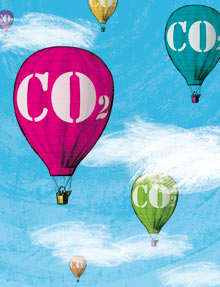The governments across the world revises their plans to reduce the greenhouse gas emissions in support of the Copenhagen (COP15) climate summit.
Several nations which signed up to the summit accord were asked to outline pledges by this Sunday i.e. Jan 31, 2010 and states producing at least two-thirds of emissions have done so.
The COP15 accord has been widely accounted as a disappointment for not reaching a treaty however, the kind of support it is gaining is indicating that the prospects of a legally binding deal may emerge in the later part of the year.
Several developing countries across the world which are facing the worst impacts from climate change seem quite willing to sign up to the agreement, as this would include firm level of commitments on funding in both the short and the medium terms.
Though a few others are unhappy with the idea that the accord could emerge as a new basis of negotiations towards a legally binding treaty, and it can be feared that some may refuse to associate with it.
Several Leading emitters such as the US, India, China and the EU have already written in whereas some of the smaller emitters have also sent pledges or asked to be associated with the deal.The Secretariat of the United Nation's Climate Change says that it will publish a list of signatories on Monday.
Last year's December Copenhagen climate conference reached an accord including a recognition to limit temperature rises to less than 2C (3.6F). It also promised to deliver $30bn (£18.5bn) worth of financial aid for developing nations over the next three years, to cope with the impact of climate change, and further funds to help them reduce emissions.
But analysts across the world say the accord looks unlikely to contain temperature rises to within 2C, the threshold that UN scientists say is needed to avert serious climate change.
US-LED COPENHAGEN DEAL
- No reference to legally binding agreement
- Recognises the need to limit global temperatures rising no more than 2C above pre-industrial levels
- Developed countries to "set a goal of mobilising jointly $100bn a year by 2020 to address the needs of developing countries"
- On transparency: Emerging nations monitor own efforts and report to UN every two years. Some international checks
- No detailed framework on carbon markets - "various approaches" will be pursued
Updated: 13:47 GMT, 19 December
Environmentalists and aid agencies have branded it a failure, but UN Secretary General Ban Ki-moon described the deal as an "essential beginning".
BBC environment reporter Matt McGrath says the accord lacks teeth and does not include any clear targets on cutting emissions.
But if most countries at least signal what they intend to do to cut their emissions, it will mark the first time that the UN has a comprehensive written collection of promised actions, he says.
The next round of negotiations is due to be held in December in Cancun, Mexico.
It is unclear whether a legally binding deal can be reached at Cancun, amid uncertainties such as about whether the US Congress can pass a bill which includes emissions reductions.
Source: BBC News








